Taping the mouth for sleep is one way to encourage breathing through the nose rather than the mouth. To do this safely, choose a gentle, breathable adhesive tape made for skin, then place a strip horizontally across the lips without covering the nostrils. This can help reduce dry mouth and snoring, and it may improve sleep quality for some people.
Many who try mouth taping notice better results when they combine it with healthy sleep habits and a comfortable mattress. It is important to watch how the body responds, especially if there are any breathing issues or sleep disorders. Since mouth taping does not suit everyone, knowing how to apply it correctly and being aware of potential risks make all the difference in using this method safely.
Key Takeaways
- Use gentle and skin-safe tape across the lips to encourage nasal breathing.
- Mouth taping may lessen snoring and dry mouth, though it does not work for everyone.
- Combine mouth taping with good sleep habits and proper support to get the best outcomes.
- Mouth taping and a supportive mattress help maintain proper body alignment and encourage nasal breathing, which leads to better oxygen flow, reduced snoring, and improved overall sleep quality.
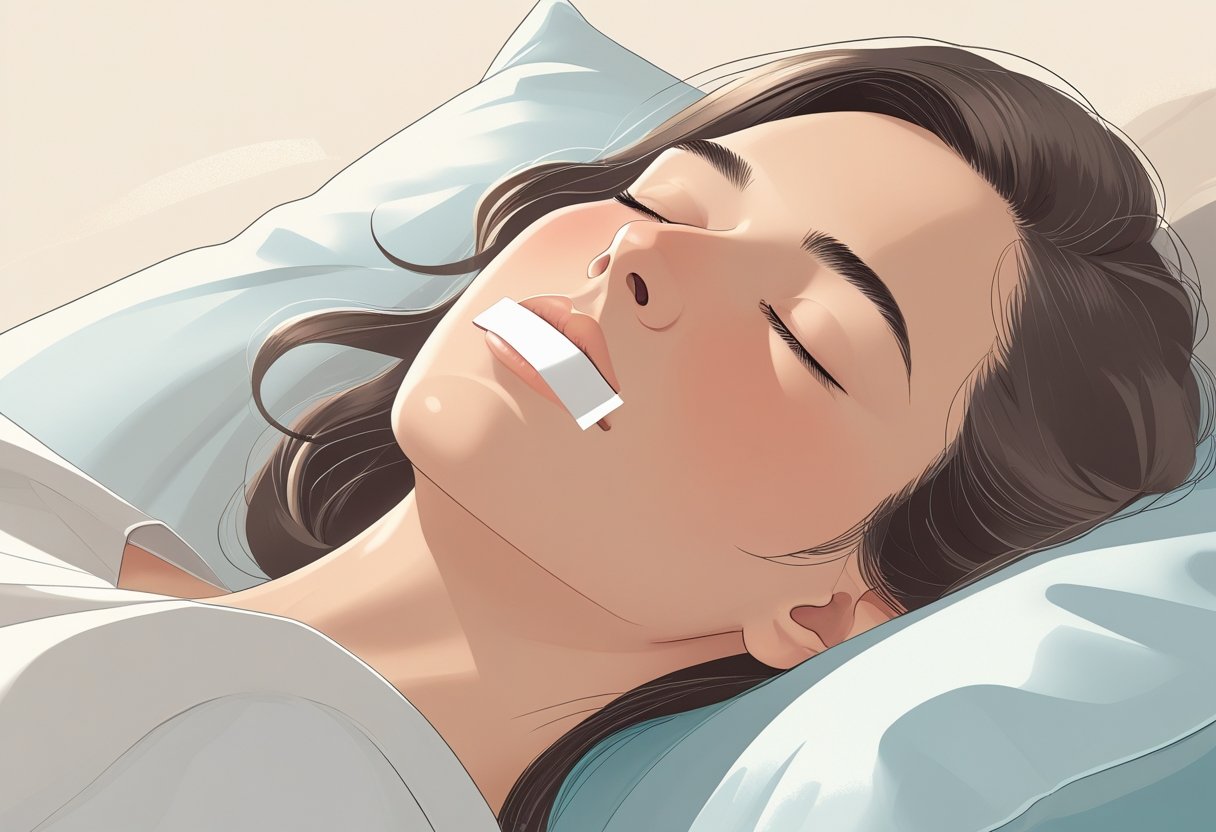
What Is Mouth Taping?
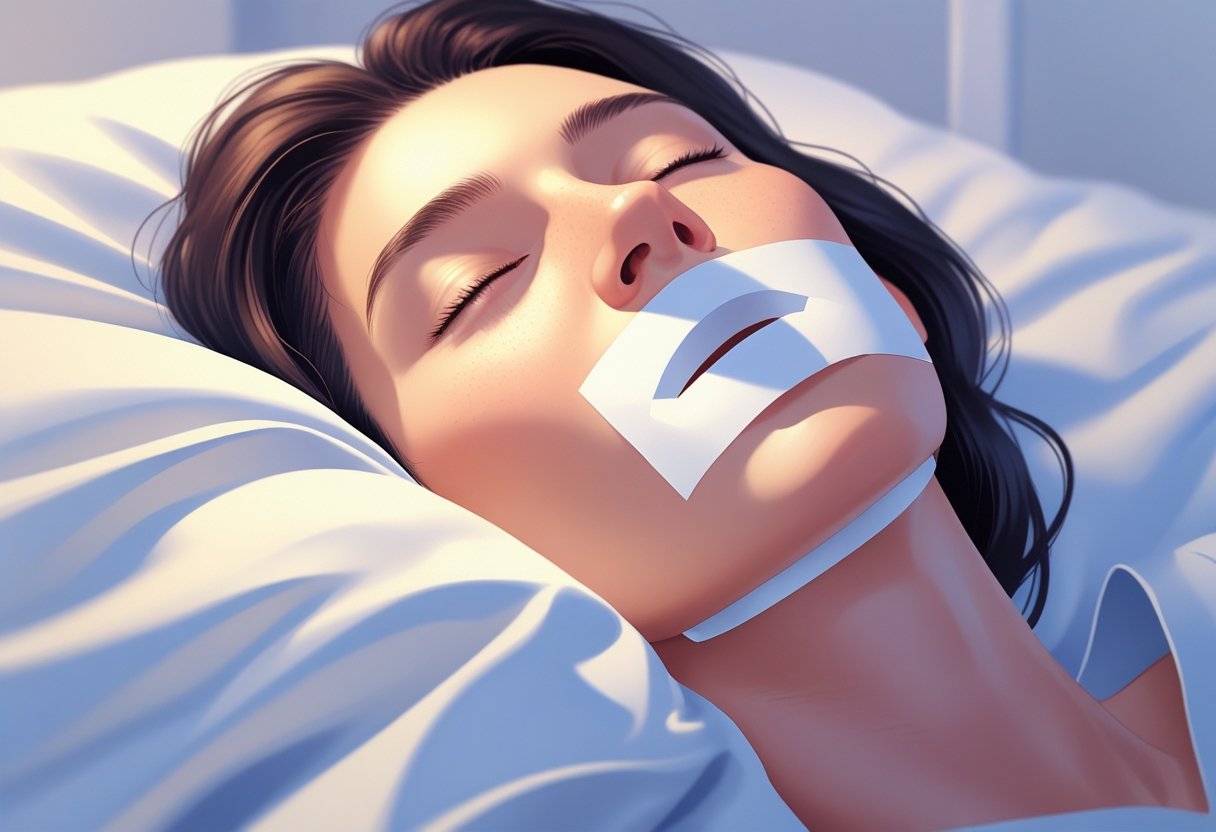
Mouth taping uses a special type of tape placed over the lips during sleep. This practice keeps the mouth closed, so people breathe through the nose instead. The method remains simple yet offers different options and a clear purpose compared to other snoring remedies.
It’s known as a natural way to improve breathing habits during sleep while reducing dry mouth or snoring caused by open-mouth breathing. People use various tapes and approaches depending on their needs or preferences.
Definition and History
Mouth taping seals the lips with adhesive tape to stop mouth breathing during sleep. The goal is to encourage nasal breathing, which helps maintain better air quality and moisture levels. This technique is not new, since athletes and certain cultures have relied on mouth coverings to support healthy breathing patterns for decades.
In recent years, mouth sleep tape has attracted more interest from people who want a simple tool to improve sleep quality without medication. However, mouth tape does not treat sleep apnea. It only encourages nasal breathing in healthy individuals.
Types of Mouth Tape
Several types of mouth tape exist, each designed for comfort and safety. Common varieties include:
- Medical-grade tape: Gentle and hypoallergenic, suited for sensitive skin.
- Sport sleep tape: Made to stay in place even if someone moves a lot during sleep.
- Special mouth strips: Pre-cut adhesive strips shaped for lips, often marketed as “mouth strips for snoring.”
People should choose tapes that avoid irritation or discomfort. Some tapes come off more easily or feel more breathable, which matters for safety and usability. Strong adhesives that might hurt or pull the skin should be avoided.
How Mouth Taping Differs From Other Snoring Solutions
Mouth taping differs from common anti-snoring devices such as chin straps, nasal sprays, or oral appliances. Rather than mechanically forcing the jaw or opening airways, mouth tape simply encourages natural nasal breathing.
Unlike snoring mouth strips that claim to open nasal passages, mouth tape focuses on keeping the lips closed. It does not use a device inserted inside the mouth or nose, which makes it less invasive.
Mouth tape for sleeping acts as a passive approach, relying on the body’s ability to breathe through the nose instead of changing physical structures. This is a simple option for people who want to support nasal breathing without complex equipment or prescriptions.
How Does Mouth Taping Work?
Mouth taping places a strip of tape over the lips to keep the mouth closed during sleep. This method seeks to encourage breathing through the nose, which could offer certain benefits. Knowing the differences between mouth and nose breathing, along with the reasons for using mouth tape, clarifies how this practice works.
Mouth Breathing Versus Nose Breathing
Mouth breathing occurs when air enters through the mouth rather than the nose, causing dry mouth, irritation, and sometimes snoring. In contrast, nose breathing filters, warms, and humidifies air before it reaches the lungs, which can improve oxygen intake and support better sleep quality.
Breathing through the nose also produces nitric oxide, which aids circulation and lung function. Many people breathe through their mouths at night due to nasal congestion or habit. Mouth taping aims to reduce mouth breathing by gently sealing the lips during sleep.
The Purpose of Mouth Tape
Mouth tape prevents mouth breathing at night. By taping the mouth shut, it encourages nasal breathing instead. This may help with dry mouth, reduce snoring, and improve overall sleep comfort.
The tape is usually gentle and designed to allow the lips to part slightly, so the person can still breathe if needed. Mouth tape does not treat serious conditions like sleep apnea, yet some people use it to promote better nasal breathing habits. It is important to choose safe and hypoallergenic tape intended for skin.
The Science Behind Mouth Taping
Scientific evidence remains limited on whether mouth taping improves sleep or treats breathing issues. Nevertheless, nasal breathing has proven benefits, such as better oxygen exchange and effective air filtration. The tape functions by physically preventing the mouth from opening.
By promoting nasal breathing throughout the night, mouth tape may reduce snoring and dry mouth symptoms. However, it is not widely recommended for those with breathing problems like obstructive sleep apnea without medical advice. More research is necessary to determine the long-term effects and safety of mouth taping during sleep.
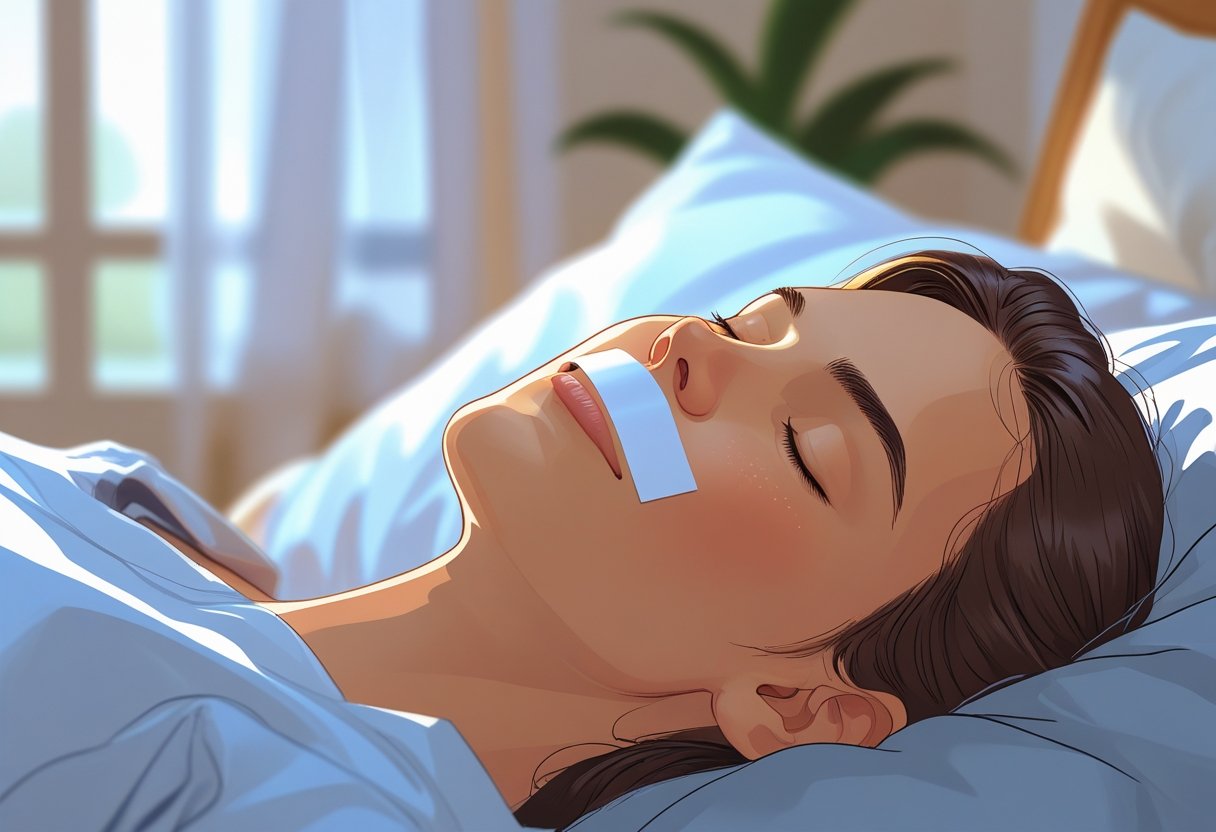
Benefits of Mouth Taping for Sleep
Mouth taping affects several aspects of sleep and health by encouraging nasal breathing. This simple practice may reduce snoring, improve breathing patterns, and offer additional health benefits tied to better oxygen flow throughout the night.
Improved Sleep Quality
Mouth taping promotes breathing through the nose, which improves oxygen intake. Nasal breathing warms and filters the air, making deep, comfortable breaths easier. This results in more restful sleep.
Many who use mouth tape report fewer awakenings and longer periods of deep sleep. Keeping the mouth closed prevents dry mouth and throat irritation, which can cause discomfort and disrupt sleep. Though more research remains necessary, some believe stabilizing breathing with mouth tape reduces sleep disturbances linked to mouth breathing. This can lead to better overall sleep quality.
Reduction in Snoring
Reducing or stopping snoring stands out as a primary reason many turn to mouth tape. Snoring occurs when the mouth hangs open, causing the airway to vibrate noisily. Keeping the mouth shut helps keep the airway more stable. Mouth taping encourages nasal breathing, which can lower the likelihood of snoring for many people. However, it does not serve as a guaranteed cure for every type of snoring or sleep apnea.
Remember that mouth taping should never replace medical treatment for severe snoring or sleep apnea. While it may ease mild to moderate snoring, it should always be used with caution and professional guidance if sleep apnea is a concern.
Other Health Benefits
Taping the mouth at night can minimize dry mouth and bad breath by discouraging mouth breathing. This maintains saliva levels that protect teeth and gums. Nasal breathing also supports healthier carbon dioxide levels in the body, which improves blood flow and oxygen delivery to tissues.
People with minor sleep apnea symptoms or those searching for ways to improve breathing habits may find mouth taping helpful. It encourages a healthier breathing pattern, which can ease issues like morning headaches or daytime fatigue.

Is Mouth Taping Safe?
Mouth taping involves placing tape over the lips to keep the mouth closed during sleep. This practice encourages nasal breathing but raises questions about safety. The potential risks, who should avoid it, and the importance of professional advice are key considerations for anyone thinking about this method.
Possible Risks and Precautions
Taping the mouth shut at night may cause discomfort for some people. It can lead to skin irritation or allergic reactions from the adhesive. If the tape holds too strongly, it could damage the skin when removed. More importantly, breathing difficulties can occur. People who experience nasal congestion or blockages might struggle to breathe if their mouth stays sealed, which increases the chances of sleep disruptions or panic.
Mouth taping does not treat conditions like sleep apnea. It could worsen breathing problems for those with underlying sleep disorders. Using gentle tape designed for skin and testing a small area first helps reduce some risks.
Who Should Avoid Mouth Taping?
Mouth taping is not safe for everyone. People with respiratory issues, including asthma, chronic nasal congestion, or sleep apnea, should avoid it altogether.
Children and older adults should also avoid taping their mouths shut because of risks related to breathing and skin sensitivity. Anyone with claustrophobia or anxiety about restricted breathing may find the practice distressing or harmful. Pregnant women need to consult a doctor before trying mouth taping. Those recovering from recent facial surgery or infections near the mouth should avoid it due to the risk of irritation or complications.
Consulting With Healthcare Professionals
Before taping the mouth shut for sleep, speaking with a healthcare professional is essential. A doctor can determine whether nasal breathing is safe and can check for sleep disorders like apnea. Healthcare providers might recommend safer alternatives or suggest breathing exercises tailored to individual needs. They could also advise on suitable types of tape and ways to use them without causing harm.
Professional guidance helps prevent using methods that worsen breathing or irritate the skin. This step becomes especially important for people with chronic health issues or those uncertain about the safety of tape on their skin.
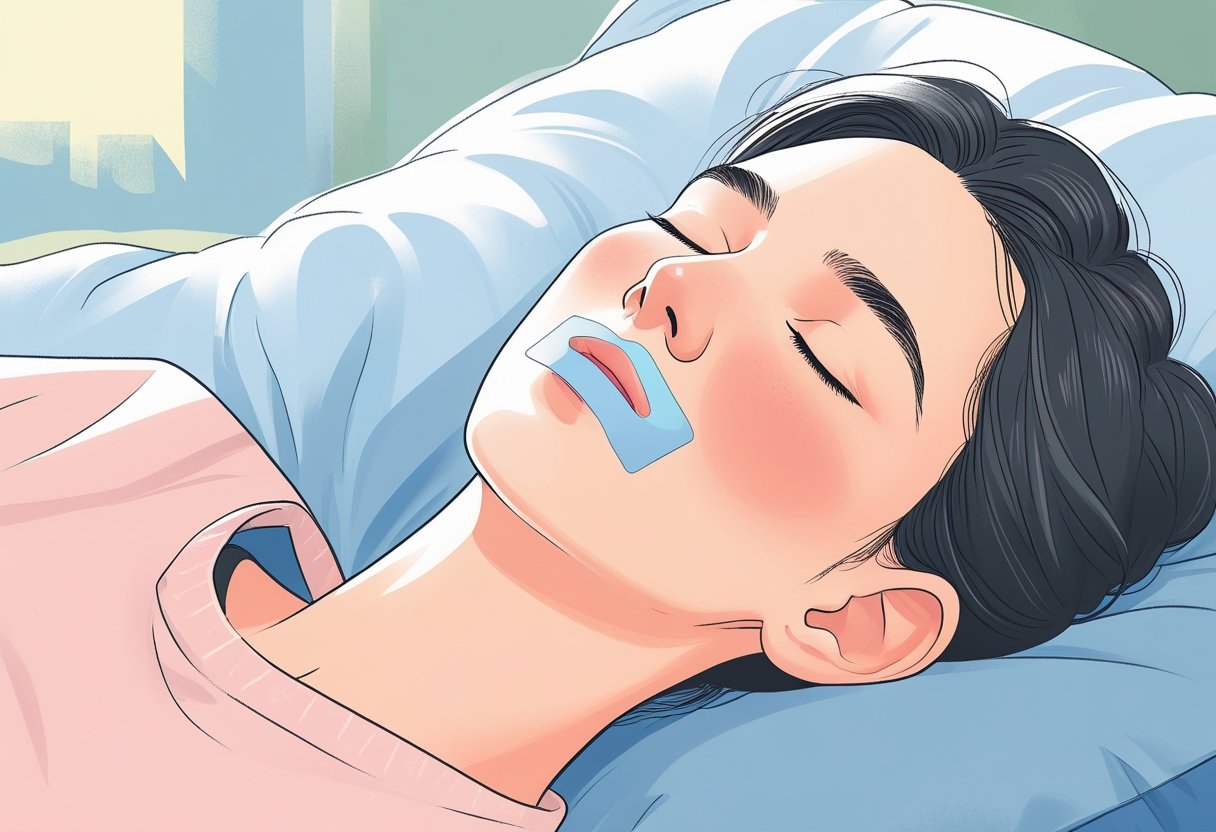
How to Tape Your Mouth for Sleep
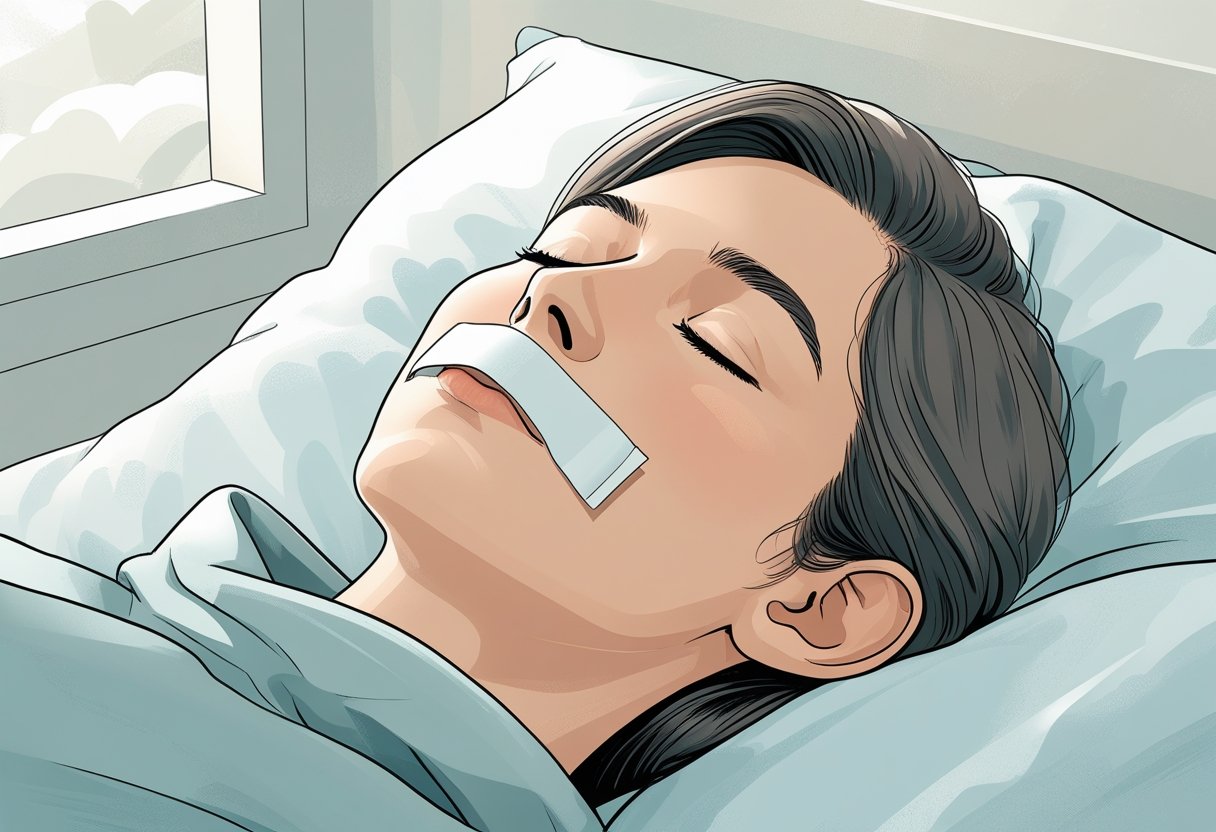
Mouth taping for sleep means choosing the right tape and applying it carefully to encourage nasal breathing. The correct technique and tape selection improve comfort and safety. Beginners should expect a short adjustment period and follow clear steps to tape their mouth properly.
Step-by-Step Instructions
First, clean your lips and the area around them to remove oils or moisture, which helps the tape stick better and stay in place through the night. Next, tear a small strip of tape about 2-3 inches long, then place it horizontally over your closed lips without covering your nose or chin.
Press the tape gently yet firmly so it adheres well. Some people prefer using a small piece placed in the center of the lips if sealing the entire mouth feels uncomfortable. Before fully falling asleep, check if the tape feels secure but not too tight. If necessary, adjust or remove it to avoid any breathing difficulties.
Choosing the Right Mouth Tape
Select a tape made for skin use so you can avoid irritation. Medical-grade, hypoallergenic tapes suit mouth taping best. Stay away from regular adhesives like duct tape or masking tape since they can cause skin damage or discomfort.
Lip tapes designed for sleep usually feature a porous and gentle construction, allowing slight airflow and easy removal in the morning .Some tapes include a split design or added flexibility, which helps reduce resistance when your mouth opens slightly during sleep. Use tapes labeled for sensitive skin if you have allergies or plan to tape your mouth regularly.
Tips for First-Time Users
Try taping during short naps or the first part of the night so you can get used to sleeping with tape on your mouth. If you feel anxious, use a smaller strip or tape only part of your lips to allow some airflow.
Keep scissors close by so you can remove the tape quickly if needed, since comfort and safety should always come first. Avoid mouth taping if you have breathing problems or conditions like severe sleep apnea unless you speak with a doctor first. Drink enough water before bed to help reduce dry mouth if you use taping to stop mouth breathing or snoring.
Expected Results and What to Monitor
Mouth taping encourages nasal breathing during sleep, which affects snoring, dry mouth, and overall sleep quality. Many users notice changes in comfort, breathing patterns, and sleep symptoms. Observing these shifts helps determine whether mouth taping is beneficial or if any adjustments are necessary.
What to Expect When You Start
During the first few nights, some may feel odd or slightly uncomfortable with tape on their lips. It usually takes a few days to adjust to the sensation and get used to breathing through the nose consistently.
People report less mouth dryness and reduced snoring over time. Yet if nasal congestion or discomfort arises, breathing through the nose becomes more difficult. This issue indicates it’s essential to resolve nasal problems before continuing with mouth taping.
Users should also look out for irritation from the adhesive, especially when skin is sensitive. Selecting the right tape and applying it carefully helps minimize this risk.
Mouth Taping Before and After
Before starting mouth taping, common issues include noisy breathing, waking up with a dry mouth, or having a sore throat in the morning. After consistent use, many notice reduced snoring and better hydration in the mouth.
Sleep feels more restorative since nasal breathing improves oxygen intake and limits disruptions caused by breathing through the mouth. However, results differ depending on individual health conditions such as mild sleep apnea.
Changes don’t always happen immediately. Tracking progress by comparing symptoms and sleep quality before and after using mouth tape helps evaluate its effects.
Tracking Your Progress
To gauge success, note changes in snoring, mouth dryness, or overall sleep quality. Keeping a sleep journal with daily reflections on how rested you feel provides valuable insight into improvements or new issues. Apps or devices that record breathing patterns and sleep quality offer objective data to support personal observations.
If mouth taping leads to worsening breathing difficulties or skin irritation, it’s best to stop and seek advice from a doctor. Regular nasal health checks remain important since blocked nasal passages lower the tape’s effectiveness. Treating nasal congestion appropriately improves the results of mouth taping.
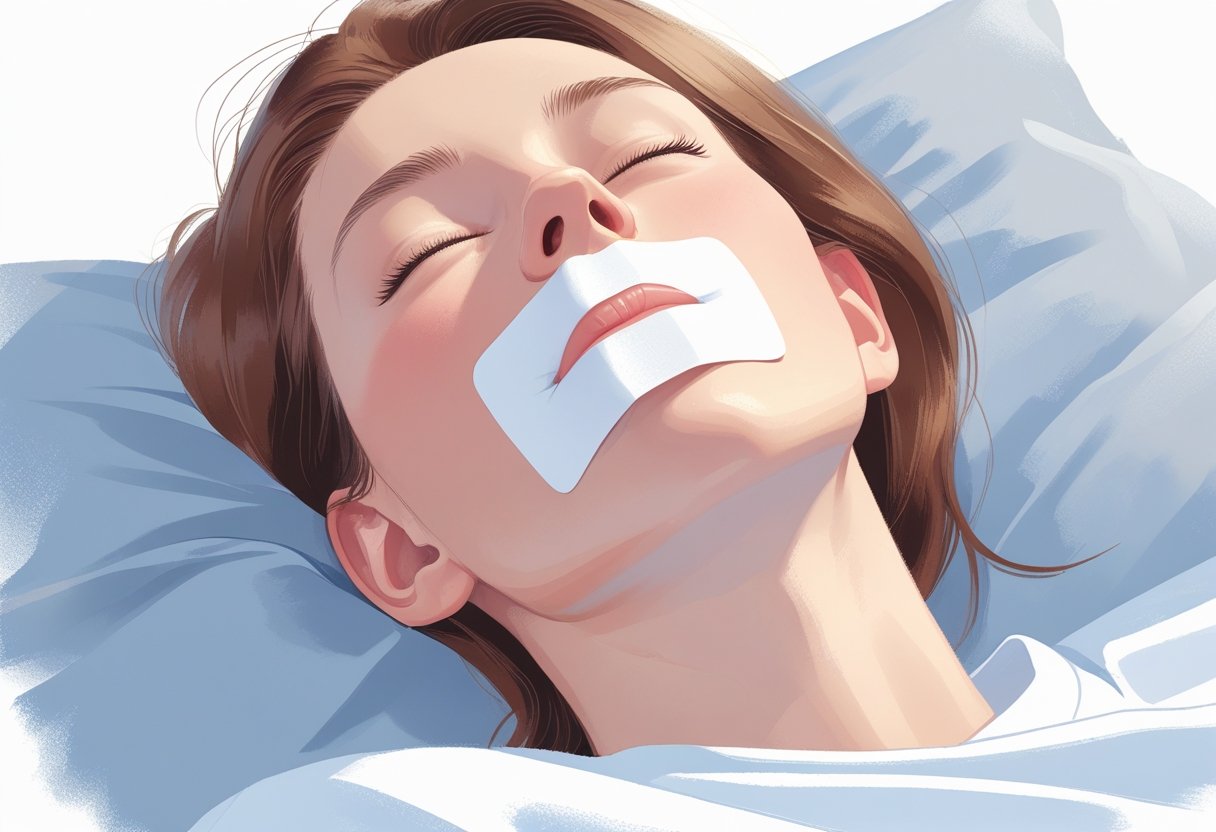
Alternatives and Complementary Solutions
There are many ways to improve breathing during sleep beyond mouth taping. Physical tools, lifestyle adjustments, and medical treatments each address different causes of snoring and mouth breathing.
Other Snoring Solutions
Devices such as nasal strips open nasal passages, which allows better airflow. Special pillows shift sleep posture to keep airways open, reducing snoring. Some people discover that sleeping on their side rather than their back stops mouth breathing. Combining these methods improves breathing without the need for tape.
For mild cases, over-the-counter oral appliances fit inside the mouth and move the jaw forward, which prevents airway collapse. These options sometimes prove safer than papmd mouth tape and reduce dry mouth and snoring effectively.
Lifestyle Changes
Simple changes in habits support better nighttime breathing. Keeping a healthy weight eases pressure on airways. Avoiding alcohol and sedatives before bed helps muscles stay firm, which keeps airways clear.
Treating allergies improves nasal airflow and reduces the need for mouth breathing. Good sleep hygiene, like maintaining a consistent bedtime routine, also encourages nasal breathing.
When to Consider Medical Devices
When snoring or mouth breathing results from sleep apnea, medical devices become necessary. CPAP machines deliver steady air pressure to keep airways open through the night. Dentists or sleep specialists can prescribe custom oral appliances if other methods fail. Before trying papmd mouth tape or any taping method, speaking with a doctor ensures safety, especially for those with breathing issues.
These devices work best for moderate to severe cases when simple lifestyle adjustments or over-the-counter products do not provide relief.
How the Right Mattress and Mouth Taping Work Together for Better Sleep
Mouth taping encourages nasal breathing during sleep. Breathing through the nose improves oxygen flow and reduces dry mouth. This technique works best when combined with a good mattress that supports proper body alignment.
A supportive mattress keeps the spine in a neutral position, which reduces discomfort that can cause restlessness. When the body feels comfortable, breathing smoothly through the nose throughout the night becomes easier. For instance, hybrid mattresses like the Layla Hybrid Mattress provide excellent support and pressure relief for proper alignment all night long.
The Layla Hybrid Mattress combines copper-infused memory foam with individually wrapped coils. This design gives the contouring comfort of foam along with the responsive support of springs. The copper infusion assists with temperature regulation and provides antimicrobial benefits.
Additionally, the Layla Hybrid Mattress features a flippable design with two firmness options in one mattress. This versatility lets sleepers select the side that best suits their comfort preferences and sleeping style, which is an important factor when choosing a mattress that supports proper breathing posture throughout the night.
Some benefits of combining mouth taping with the right mattress include:
- Improved breathing: Nasal breathing filters and humidifies air more effectively.
- Reduced snoring: Mouth taping helps decrease open-mouth breathing, a common cause of snoring.
- Better sleep quality: Comfort from a proper mattress encourages deeper and uninterrupted sleep.
Choosing a mattress based on personal needs, such as firmness and pressure relief, is important. A mattress that fits well supports the head, neck, and back, which makes it easier to maintain nasal breathing.
Trying mouth taping without a comfortable mattress may lead to discomfort or poor sleep. While taping the mouth encourages breathing changes, the mattress plays a key role in overall sleep posture and comfort.

Frequently Asked Questions
Mouth taping aims to promote nasal breathing during sleep and can affect snoring, dry mouth, and sleep quality. It carries some risks and requires careful selection of appropriate materials and methods.







